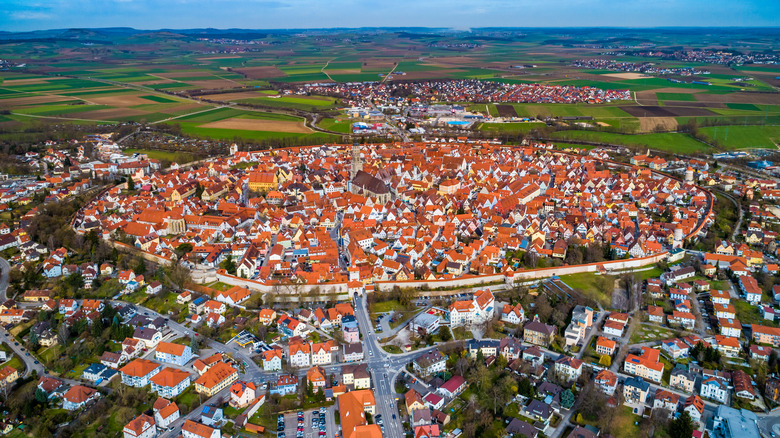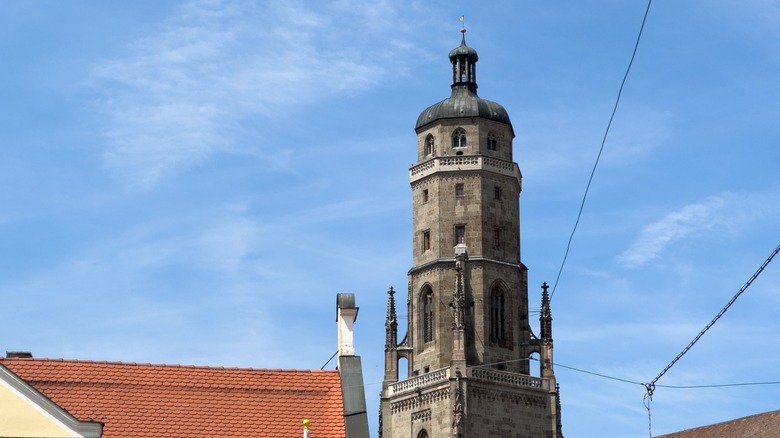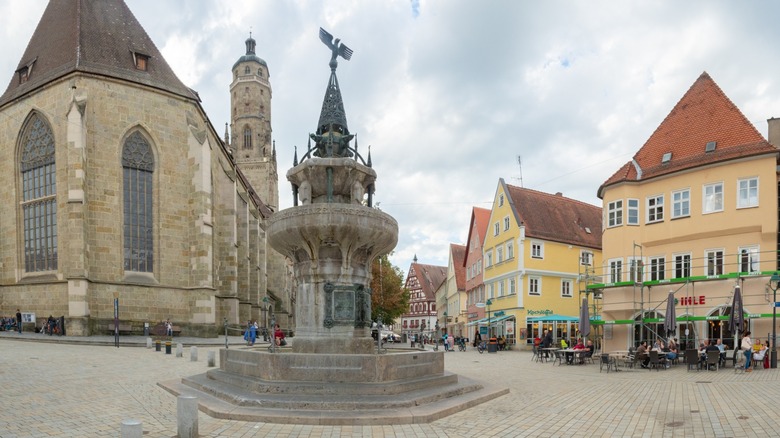Located On Germany's Romantic Road Is A Town With An Out-Of-This-World Origin Story
The German town of Nördlingen owes its entire existence to an intergalactic accident. A cool 15 million years ago, a meteorite crashed in the Alb highlands at a temperature of more than 20,000 degrees Celsius. Its impact caused a shockwave in the Earth, forming high-pressure minerals — including diamonds – and settling into a wide, shallower crater hole measuring more than 15 miles across as the rocks finally settled. The area within the crater, the Geopark Ries basin, contains the town of Nördlingen and several others within the 15-mile radius of the crater. This UNESCO Global Geopark gives visitors the chance to explore the planetary geology and history of this richly interesting area, with Nördlingen a prominent center.
First mentioned in the year 898 as an independent town along the Romantic Road trading route, Nördlingen slowly came into being in the Middle Ages. In the 14th century, residents of the free city built a circular wall around it, constructed of Suevite rocks formed by the crater's impact. St. George's Church, as well as the Baldinger gate and city hall, are also constructed from Suevite, which glistens in the sun. For international visitors arriving from Munich, you'll get to see one of the most bizarre attractions in an airport before making the 90-mile trek north to visit Nördlingen. The town provides a fascinating look at one of Bavaria's best-preserved Medieval cities and makes a spectacular outing for geology and cosmology nerds.
Nature and architecture blend in the town's landmarks
Take a guided driving tour of the Ries crater region by requesting a booking through the Nördlingen tourism site or asking at the city's tourism information office at Marktplatz 2, which is open weekdays from 9 a.m., year-round. Between Easter and the end of October, it also keeps Saturday and holiday hours from 10 a.m. until 2 p.m. To learn even more about the crater and the study of it by scientists from NASA and Bavaria, visit the Ries Krater Museum. It opens from Tuesday through Sunday and on most public holidays.
From the town itself, the best way to see the crater is to climb to Nördlingen's highest point, St. George's church tower, which is called the Daniel. At almost 300 feet tall, it's also a great point from which to admire the rest of the town's red roofs and historic architecture. When you make your way back down to street level, book a room in the Kaiserhof Hotel Sonne on Marktplatz 3. As the oldest guesthouse in Bavaria, its history of more than 600 years gives the hotel an eternal charm. The hotel's historic wine cellar, das Stäpfele, is located in the basement and makes for a cozy Friday or Saturday night.
Nördlingen can compete with the best of Germany's beautiful small towns
Like other destinations on Germany's Romantic Road known for grand palaces and churches, Nördlingen has its share of impressive buildings and medieval architecture. In fact, the 'Romantic Road' route, a tourist path vaguely inspired by Roman roads in southern the German states of Bavaria and Baden-Württemberg is a great place to find many of Germany's visual and architectural highlights. You can feel the magic from the stunning castle that inspired Disney, escape Munich's crowds for a city that's been called one of Germany's most beautiful, or visit the tourist trap that Rick Steves admits is one of his favorite European towns, all without leaving the famed Romantic Road.
With all of these beautiful places to visit in just two of Germany's 16 states, it would be easy to think that the south was the only area worth visiting. But then you'll miss Germany's underrated 'Venice of the North', and the northeastern German town with storied streets, lush parks, and a music festival honoring one of Germany's most notorious composers. So after you complete the Romantic Road, don't forget to keep exploring.


